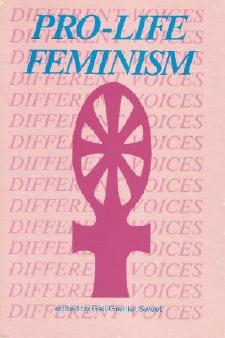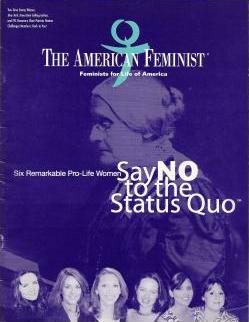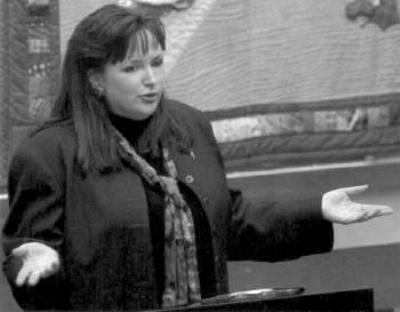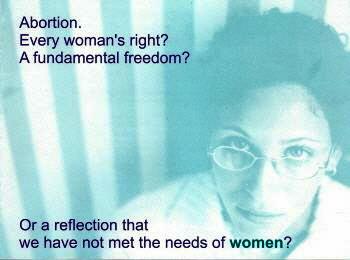|
This article appeared in Human Life Review, Summer 2008. Copyright © 2008 by Mary Meehan.  Feminists for Life on Campus "I understand why people want to say no to abortion," Serrin Foster remarks. "But what drives Feminists for Life is how we say yes to women, yes to life. And honor fathers.... Celebrate womanhood, but honor fathers, and cherish every life."(1) As president of Feminists for Life of America (FFL), Foster is working for a country that welcomes children and gives their parents--especially their mothers--the support they need. From her own family's experience, she knows that avoiding abortion is not enough by itself. Her mother was an early volunteer for Birthright, the network of pregnancy care centers. She was so concerned about helping pregnant women, Foster says, that she once "proposed that we turn our rec room, our family room, into a maternity home." (That, alas, was not doable.) Foster's father, growing up during the Depression, was just a toddler when he lost his father. His mother was poor; so the little boy bounced around from one foster family to another, suffering neglect and abuse. Later, Foster says, her father was well-cared for by an elderly couple who "loved him dearly." But they couldn't adopt him because his birth mother would not consent, even though she had remarried and her second husband did not want to "take in another man's son." Another family experience helped prepare Foster for today's major focus of FFL: making college and university campuses more friendly to pregnant and parenting students. On the day her father graduated from college, he was photographed in cap and gown as he held little Serrin in his arms. He and his wife were expecting their second daughter at the time. Mrs. Foster attended college later, at the same time Serrin did.(2) One Foot in Each Camp Pat Goltz and Catherine Callaghan started Feminists for Life in 1972, when both were living in Ohio. Callaghan, a longtime professor of linguistics at Ohio State University, now has emeritus status there. Goltz and her husband currently live in Arizona; they have seven children, including two whom they adopted. Goltz has worked in art and website design. Goltz and Callaghan thought support for abortion contradicted basic principles of feminism. "They can't do that to my movement!" Goltz said of feminists who backed abortion.(3) Unfortunately, they could and they did. The Ohio chapter of the National Organization for Women (NOW) even expelled Goltz because of her outspoken opposition to abortion. Yet she and Callaghan had planted a flag other pro-life feminists could rally around. For years FFL operated with almost no money, usually from the homes of a series of Midwestern presidents and other volunteers. It was a feisty little gadfly, annoying establishment feminists with quotes from early American feminist leaders who were strongly against abortion. The group produced thought-provoking literature, and many of its members contributed to a 1985 anthology called Pro-Life Feminism: Different Voices.(4)  FFL moved its headquarters to Washington, D.C., in 1994, hiring Serrin Foster as executive director. (Later she would become president of the group.) Soon she was lobbying on Capitol Hill--against the "family cap" in a welfare-reform bill, for example, and for a bill to prevent violence against women. Since so many women's groups who supported the second bill also backed abortion, Foster wasn't sure how they would receive her. She recalls entering a room where they had gathered "and saying that I was with Feminists for Life and feeling the tension in the room, and the suspicion." But she also remembers that Pat Ruess, a veteran feminist activist who chaired the meeting, called out, "'Welcome! We welcome you!'" She believes Ruess "was very smart in understanding" that her coalition needed access to the pro-life community in order to put legislation through. With a foot in each camp, FFL still has a unique role to play on Capitol Hill. When working with pro-lifers, Foster says, "we're the ones responsible to engage the left. But when we work with the left, the women-centered side of things, we're usually assigned to...get enough people to help us on the right," something they did "with the Family and Medical Leave Act." At some point, though, Foster wondered if she might be taking on too much. In addition to her lobbying work, she was speaking on many college campuses and developing special ads to reach college students, and was also involved with policy issues at the United Nations. She sought advice on priorities from two old Washington hands who had a wealth of organizational experience with the Peace Corps and the Special Olympics: Sargent Shriver and Eunice Kennedy Shriver. Foster had met Mrs. Shriver at a pro-life dinner in New York and later had helped her with a special event. The Shrivers, she says, advised that "you really have to think about what is uniquely yours.... You really need to say this is your big idea; this is your focus; and this is your priority." Foster and her colleagues believed their college outreach work was what they did best. They decided to make that their top priority, working on campus to eliminate systematically "the root causes that drive women to abortion." They are making progress despite still having a small budget and staff. Their most recent Form 990 IRS report showed annual income of slightly over $500,000. Most of that came from contributions, and some from honoraria for campus speaking engagements.(5) Besides Foster, the group currently has one other full-time staff member, Cat Clark, plus two part-timers. Now based in Alexandria, Va., they have what Foster calls a "boutique office." They receive help from volunteers around the country, including women who have valuable professional and media experience. Their summer-intern program trains students who are ready to lead when they return to campus in the fall. And FFL works closely with Students for Life of America, a relationship that has strengthened both groups. FFL also has a group of speakers, besides Foster and other leaders, who have interesting stories to tell on campus. One woman survived an abortion by saline solution. Another decided against abortion despite not knowing whether her child's father was her boyfriend or a rapist. Another placed her little daughter in an open adoption.(6) Contributors to the FFL magazine, The American Feminist, have made it a lively publication. One issue focused on low-cost ways to raise children. Several others described "Remarkable Pro-Life Women" in politics, medicine, media, and other key fields. The usual print run is 10,000 copies, but some issues have gone up to 20,000.  The FFL pro bono attorney for years was Jane Sullivan, who also served on their board. While volunteering for the group, Sullivan met and married attorney John Roberts, who is now Chief Justice of the U.S. Supreme Court. Feminists for Life received a bonanza of publicity when Roberts was nominated to the high court. Actresses Margaret Colin and Patricia Heaton still help the group catch the public eye. Heaton, honorary FFL chair, is an Emmy award winner and a mother of four. Her watchword is: "Women who experience an unplanned pregnancy also deserve unplanned joy."(7) What Young Women Face It's hard for many pregnant women on campus to find that unplanned joy. All too many believe their only choices are having an abortion or leaving college to have their children--and possibly never finishing their education. Feminists for Life, drawing on the actual experience of a former board member, puts it this way in one of their college ads: "They Say I Have a FREE CHOICE. But without housing on campus for me and my baby, without on-site daycare, without maternity coverage in my health insurance, it sure doesn't feel like I have much of a choice."(8) Housing, childcare, and insurance coverage are still major problems. Sometimes, though, there are major sources of support that students just don't know about. Sometimes staff of a campus health center or counseling service don't know about them, either. Often they are more likely to know about the nearest abortion clinics and to refer students to them automatically. The FFL program is designed to ensure that students are offered information on positive alternatives. When challenged, it's hard for administrators or students who take a "pro-choice" position to be against offering all the choices. Some, in fact, really are pro-choice and work with FFL on alternatives. Other obstacles often add to the stress of financial pressures on pregnant students: strict class-attendance requirements that are hard to meet when morning sickness is severe; inability to park near classrooms when walking is difficult during late pregnancy; small student desks that are hard to fit into as the due-date approaches. After delivery, problems include lack of diaper-changing stations in campus restrooms and scarcity of private places on campus to nurse a baby. Minor policy changes and a little extra spending can remedy these problems, but some faculty and administrators are either too rigid to make the changes or totally unaware of the problems. Perhaps worst of all for the young women is the social stigma of being pregnant while unmarried--or, in the eyes of some, being pregnant at all. One student, who married her child's father after becoming pregnant, spoke for herself and others when she mentioned "disapproving looks, rude stares at our pregnant bellies...and a society that wants women to choose either education and career or children." She had enrolled in the federal WIC program, which pays for supplemental food for expectant mothers of limited income. On one trip to the supermarket, she tried to use a WIC coupon for cereal, not realizing she had chosen a brand WIC doesn't cover. A cashier noticed the error, called a co-worker over, and the two "very publicly reprimanded me. As the line grew behind me and impatient foot-tapping filled the air, my eyes welled with tears and my face burned red. I knew what all the customers behind me were thinking--'Stupid girl, didn't know better than to not get pregnant, now she doesn't even know how to buy cereal!'.... Does choosing to give life to your baby while still in school mean you deserve to be publicly humiliated over a box of cereal?"(9) A Can-Do Approach Feminists for Life has developed an in-depth program to deal with all of these problems. It has sent information kits on resources to health centers at more than 600 campuses around the country. It also has run an advertising campaign on about 100 key campuses. Some ads deal with abortion per se, while others stress alternatives to it. One of the best lists national telephone helplines of pregnancy care networks and says: "If you're pregnant and don't feel like you have much of a choice, call these people. They don't want your money, they just want to help. They'll stand by you when no one else will."(10) Foster and her colleagues also invented the Pregnancy Resource Forum, an on-campus event with two major points: 1) telling students about existing resources for pregnant and parenting students; and 2) developing new ways to help such students. Usually a campus pro-life group does a survey of campus resources well before the forum. There is wide publicity for the forum itself, including ads in the campus newspaper. An FFL leader moderates a panel that may include representatives from campus counseling, the health center, housing office, financial-aid office, and campus ministry, plus a local pregnancy care center and sometimes an adoption agency. Students can question the panelists and make their own suggestions. "The blueprint for progress that we come together with at the end of a Pregnancy Resource Forum," says Foster, "is tailored for that school." Feminists for Life can't do its part for free; a campus usually pays it several thousand dollars for honorarium, travel costs, and materials for a forum. (Such payments don't cover the whole college outreach program, Foster says, since there is "constant, ongoing training and developing and problem-solving for campuses.") An enterprising college group that is short of money might do a forum entirely by itself, using the FFL website and materials. Georgetown University, Washington, D.C., spurred by its energetic Right to Life group, hosted the first forum in 1997. Good publicity packed the auditorium. There were some protesters outside; but Foster, the moderator, invited them to come in. She stressed that the event was "not a debate over abortion" but was meant "to identify and develop resources for pregnant women, to empower them to make life-affirming choices."(11)  Serrin Foster She takes the same approach on other campuses. In a talk at Northwestern University, Evanston, Ill., last year, she appealed to people on both sides of the abortion issue: "Don't look at each other as the enemy. The only enemies we have are the status quo and accepting failure." She also told them to push the university administration. "You guys have got to get the administration to change," she declared. "Have you heard of revolutions on campuses?"(12) When there is intensive follow-up on a forum, the results can be profound. Foster says that Georgetown, a Jesuit institution, "has been amazing" and that "every year they take on another challenge." The university established a pregnancy hotline for students, assigned pregnancy- counseling responsibility to a staff member, and provided a child-proofed townhouse for parenting students. The townhouse can accommodate two mothers with their infants. The mothers pay what they normally would for a university townhouse; there is no extra charge for the babies. Georgetown also decided to have a resources forum every year. Carol Day, the Georgetown staff member in charge of pregnancy support, sees the forums as a good way to continue providing services "and improve upon them each year." The campus Right to Life group, which has worked with a local pregnancy care center for many years, also provides volunteers to babysit for student parents.(13) Speaking at California's Pepperdine University in 2006, actress Patricia Heaton drew a large crowd and emphasized the need for positive alternatives to abortion. The campus pro-life group, Dean of Students Mark Davis recalls, accepted the challenge and said they would like to host a resources forum; so "we worked together to make that happen the following year." Pepperdine, which is affiliated with the Church of Christ, established a task force to look at campus resources and develop proposals for improvement. Their solution for one problem should interest other church-related institutions. Davis notes that some students assumed the university "might kick them out" if they were pregnant outside marriage. In fact, he said, the administration was helping students to "make the best of the situation and to stay in school. But that just wasn't well known."(14) They decided to make it clear. The student handbook now says: "At Pepperdine, we are strongly committed to being a caring support system when any student becomes pregnant. Our goal is to provide resources, support, and assistance for the student to continue her studies." Then it adds: "Although Pepperdine does not support an unmarried student's choice to engage in sexual relationships, we do support any pregnant student throughout the process. We will not pursue disciplinary action regarding the matter." This is followed by a list of university staff who can provide assistance, plus a list of local pregnancy aid centers.(15) Pepperdine, which had a shortage of on-campus housing, used to tell even married students that they couldn't live on campus with children. That policy has changed; children are now welcome, and parents with children can live in a graduate-student area. There was some worry that grad students might be bothered by the noise children make; but Davis says the response "has been better than I expected" and that students seem to enjoy seeing children around. No single students with children have requested this housing so far; but they have asked for help with other problems. Pepperdine has streamlined a previously complicated process for voluntary medical withdrawal in order to aid them. A student who can't finish a semester because of her due date now finds it easier to withdraw temporarily and receive a letter of credit so she won't lose her tuition money. Davis notes, though, that Pepperdine's changes have not cost it much financially.(16) Other Encouraging Signs--and Some Problems At least 35 colleges and universities have hosted Pregnancy Resource Forums. (Only Georgetown has one every year.) I checked most of their websites, focusing especially on pages dealing with counseling centers and health services.(17) Some sites show real progress. I was astonished to find, though, that very few campus counseling centers even mention pregnancy on their pages. Many centers name worries that might lead students to seek counseling--from test anxiety and eating disorders to serious depression--yet say not one word about pregnancy or abortion. What is a pregnant, worried, and scared young woman to do when even the counseling center seems oblivious to her problems? And what are students who suffer post-abortion guilt or grief to do?  The best statements of support that I found (though not on counseling pages) are on the websites of the University of Notre Dame and Boston College. Both are positive in tone and list many specific sources of help. Thus Notre Dame declares its commitment "to life and to offering students resources that support the choice of life." It gives contact information for three staff members identified as "Pregnancy Support Advocates who can provide confidential information and assistance." It also suggests other sources of aid, both on campus and off.(18) Other campuses could use the Notre Dame statement as a template for their own. And they should be sure there are links to it on the counseling, campus-ministry, and health-center pages. Another fine example is a planned residence for pregnant college students in Belmont, N.C., that's expected to help many students stay in school. Although it didn't result from a Pregnancy Resource Forum, it has strong links with Feminists for Life. It's a project of Room at the Inn, a Charlotte-based Catholic ministry that offers residential care to pregnant women in need. Cynthia (Cindy) Brown, then director of the group, became aware of the FFL approach several years ago. After Brown studied their website, she and her board began considering a residence for pregnant college women, and Serrin Foster advised them about it. Abbot Placid Solari of the Benedictines' Belmont Abbey, a board member, thought it was a great idea. He and his fellow monks offered land where the residence could be built, next door to their Belmont Abbey College. Jeannie Wray, current director of Room at the Inn, says they are raising money now to build the residence, which will accommodate 15 women at one time. "We believe very firmly that an education is imperative" for young mothers, Wray remarks. She says students from elsewhere will be welcome, suggesting they can enroll in Belmont Abbey College, another local college, or one in nearby South Carolina. When the residence is ready, Wray expects to "hit the ground running." Meanwhile, Room at the Inn has done outreach to seven college campuses in its area and has a counselor trained to help their pregnant students.(19) The effort to improve resources on secular campuses, whether private or public, often is complicated by a campus climate that's friendly to promiscuous sex, but not to children. Judging by web pages, many staff in student health centers believe that one of their main jobs is preventing pregnancy and containing widespread sexually-transmitted infections (STIs). Staff try to accomplish these goals through free or low-cost distribution of condoms and by prescribing birth-control pills, patches, shots, and the "Plan B" or morning-after pills. While undoubtedly preventing many births, the health centers seem to have limited success in preventing sexual disease, gauging by their emphasis on testing for STIs, including HIV-AIDS. The University of Kansas wellness resource center even has a map of HIV clinics on and off campus.(20) Quite a few institutions sponsor "peer education," in which lightly-trained students tell other students about birth control and STIs. Ohio's Oberlin College has a student-run Sexual Information Center (SIC). The center's web pages feature a happy cartoon character who is holding a condom. SIC sells condoms, lubricants, dental dams, etc., and gives referrals and rides to low-cost "sexual health and family planning clinics." It also runs a special event to educate students "about safer sex in a fun atmosphere." This "Safer Sex Night" has demonstrations and workshops on such topics as "safer oral sex" and "sex toys 101." The SIC site has a brief page on "Pregnancy Resource Contacts," listing people at three local churches. Elsewhere, under "Useful Websites," it suggests one run by the National Abortion Federation and another run by an abortion clinic, but does not list any sites of pregnancy care centers.(21) Many student-health-center web pages either don't mention pregnancy or else say only that they offer pregnancy testing and counseling. Some say they offer counseling and referrals on all options. A few actually use the word "abortion." Despite all this, there are many ways to make headway on a secular campus. One is to go to the top of the campus administration and also reach out to feminist groups. That's what happened with a recent forum at a public institution, Clarion University of Pennsylvania. Forum sponsors there included the offices of the university president and the dean of arts and sciences, the campus health center, the women's studies program, Feminist Majority Leadership Alliance, Women United, and Students for Life. There was a baby-items drive on campus for three weeks leading up to the forum.(22)  A 2005 forum at Virginia's College of William and Mary did not lead to much information about pregnancy/parenting resources on the administration's web pages. But the W & M pro-life group developed a brochure, "Practical Help for You and Your Baby," that's chock-full of such information. Although it's on the Students for Life web pages, plans to make it widely available on campus in printed form apparently have stalled. The counseling-center director says he saw a version of it at one point, and "we felt their brochure was very well done." It's not clear where the bottleneck is.(23) But I suspect a major push could lead to wide distribution. Resources forums have produced more emphasis on alternatives on web pages of many other campus pro-life groups. Yet many students may never see those pages. The challenge now is to get more of the vital information onto the web pages of campus counseling and health centers--and into printed brochures for their reception rooms. Many large universities have programs to help graduate students who are parents. Opening such programs to undergrads probably should be a major goal of resources forums. The University of Chicago's Family Resource Center, although intended mainly for graduate and professional students, is also open to undergraduate parents. The center has a colorful playroom for the kids, a private place to nurse or change a baby, and even free maternity and child clothing. It also has a meeting room for parents, parenting discussion groups, a toddler playgroup, and family activities such as a "Teddy Bear Picnic" and a field trip to a Japanese Zen Garden.(24) The University of California at Berkeley has a comprehensive program to help undergraduate-student parents, and some student volunteers also offer assistance. Using Feminists for Life material, students raised money to put diaper-changing decks in campus restrooms. And each year Berkeley Students for Life run a "diaper drive" outside a Safeway grocery store, asking shoppers to donate all sorts of baby items to help student parents on campus. A volunteer who helped with one drive reported that it looked as though "the baby section of Safeway had been transferred outside. And I won't even begin to count the amount we received in dollars."(25) While many university child-care centers are open to students, fees are high and many centers are not equipped to handle infants. But telecommuting courses can allow a student to attend class from home while caring for a baby. Many schools are reluctant to offer this option, Serrin Foster says, because they see it "as second-class education. But the resistance to that is diminishing as technology just takes over the world." Volunteer babysitters provide another solution. University of Virginia students started an Undergraduate Babysitters organization. "We have approximately 25-30 volunteer sitters each semester," says Alicia Marie Dean, the group's outgoing president. Each volunteer donates 3-5 hours per week and "is paired with one family the entire semester." Undergraduates and single moms and dads have first priority for help.(26) Pressing Congress for Aid The Georgetown experience suggests the enormous advantage of having one office on campus that's responsible for improving resources and making sure students know about them. Feminists for Life now is pressing Congress to provide $10 million in matching grants to establish such offices. The plan is to give a $50,000 grant to each of 200 campuses. The offices would hold resources forums and work constantly for new or better services.  The bill proposing this is called the Elizabeth Cady Stanton Pregnant and Parenting Student Services Act. It's named for a leading American feminist of the 1800s, a feisty gal who had seven children and was outspokenly pro-life. Chief sponsor in the U.S. Senate is Elizabeth Dole (R-N.C.). Senators Ben Nelson (D-Neb.) and Robert Casey, Jr. (D-Pa.) are also on board. The dozen House sponsors, a mix of Democrats and Republicans, include longtime pro-life leader Christopher Smith (R-N.J.).(27) Congressional action is not expected before next year, but FFL leaders hope to pick up more sponsors in the meantime. They would like to see the bill become an issue in this year's presidential and congressional campaigns. Speaking of the major-party presidential candidates, Foster comments: "I really hope that the political operatives around these two will allow them to go down the path where they listen to the real needs of women." She realizes the Stanton bill may face challenge from people who worry about starting new programs in a time of huge budget deficits. But $10 million is a tiny sum--not even pocket change--when people are trying to wrap their minds around trillions of dollars in government spending. Foster calls $10 million "a very modest investment for major returns" and says she's speaking of start-up money rather than permanent subsidies. FFL co-founder Pat Goltz has mixed feelings about the Stanton bill. "I don't care much for government funding for various things," she says, "but I know that in this case, for the time being, we need the help for these women. But we need to privatize the help as fast as we can."(28) FFL has a new invention to help push the bill: a student-led Rally for Resources. Besides pressing for change on the host campus, rally organizers collect signatures on petitions for the Stanton bill.(29) Meanwhile, Serrin Foster is still thinking ahead. She would like "to have a national summit on pregnancy and parenting." Ireland did this awhile back, she says, and participants included a former prime minister as well as parliament members on both sides of the abortion debate. If Ireland can do it, why can't we? Notes 1. Serrin Foster, telephone interview by author, 13 June 2008, audio recording. Unless noted otherwise, quotations from Foster are from this interview or a follow-up interview by author, 2 July 2008, audio recording. FFL staff member Cat Clark provided additional information. 2. The American Feminist, Fall/Winter 2007, 3. 3. Quoted in Rosemary Bottcher, "Celebrating 25 Years of Pro-Life Feminism," ibid., Summer 1997, 8-9. For histories of Feminists for Life, see Rosemary Oelrich Bottcher, "The Conception and Life of FFL," ibid., Fall 2002, 3-6; and Cindy Osborne, "Pat Goltz, Catherine Callaghan and the Founding of Feminists for Life," in Mary Krane Derr and others, ProLife Feminism: Yesterday and Today, 2nd ed. (Feminism and Nonviolence Studies Association, 2005), 219-24. I am indebted to Pat Goltz for fact-checking my two paragraphs on the early years. 4. Gail Grenier Sweet, ed., Pro-Life Feminism: Different Voices (Toronto: Life Cycle Books, 1985). I contributed to the anthology and was a member of Feminists for Life at the time. 5. Feminists for Life of America, Form 990 for tax year ending June 30, 2008. 6. The American Feminist, Fall/Winter 2007, 4-19. 7. Patricia Heaton, "Rewarding Motherhood," ibid., Fall 2003-Winter 2004, 3 (original was in italics). 8. "They Say I Have a Free Choice" (Washington: Feminists for Life of America, 2000); and Nicole M. Callahan, "Revolution on Campus," The American Feminist, Summer/Fall 2004, 3-8. 9. Chaunie Saelens Brusie, "Chaunie's Story," 14 Feb. 2008 and 5 May 2008, www.feministsforlife.org/chaunie/index.htm. "WIC" means the Women, Infants, and Children program, which also provides supplemental food for babies and young children. 10. "You're Not Alone Anymore" (Washington: Feminists for Life of America, 2000). 11. Quoted in Nicole M. Callahan, "Seeds of Change at Georgetown," The American Feminist, Summer-Fall 2004, 12-14, 13. 12. Quoted in Rachel Koontz, "Speaker Wants Better Campus Services for Pregnant Students," 13 April 2007, www.northbynorthwestern.com (go to Archives and search under "pregnancy support"). 13. Quoted in Callahan (n. 11), 14. Carol Day provided additional information via an e-mail from Georgetown media relations director Andy Pino to the author, 1 Aug. 2008. 14. Mark Davis, interview by author, 21 June 2008, audio recording. 15. "Pregnancy," http://seaver.pepperdine.edu/studentaffairs/content/ handbook/2008/policy/17-pregnancy.pdf (italics in original). 16. Davis (n. 14). 17. My count of 35 campuses is based mainly on lists at www.feministsforlife.org/cop/schedulinghistory.htm. In checking websites, I may have missed some material, since some sites are huge and hard to navigate. 18. University of Notre Dame, "Assistance for Pregnant Students," http://osa.nd.edu/departments/pregnant.shtml; and "Boston College Pregnancy Services," www.bc.edu/offices/odsd/wrc/pregnancy.html. 19. Cynthia Brown, telephone interview by author, 30 June 2008; Jeannie Wray, telephone interview by author, 24 June 2008; and www.rati.org. 20. University of Kansas, www.studenthealth.ku.edu/wellness/hiv_clinic_map.shtml. 21. Oberlin College, www.oberlin.edu/stuorg/sic/. 22. Clarion University, "Pregnancy and Parenting Resources Schedules Forum," 25 March 2008; and "Clarion University Hosts Parenting Forum," 18 April 2008. 23. "Pregnancy Resources Brochure," www.wm.edu/so/studentsforlife/resources.php; Kristin Coyner, e-mail to author, 11 July 2008; and Kelly Crace, telephone interview by author, 31 July 2008. 24. Dasha Vinogradsky, "Some Students Juggle Papers, Exams, Diapers," 19 Oct. 2007, www.chicagomaroon.com (search under "pregnancy"); and "Family Resource Center," http://grad-affairs.uchicago.edu/services/parents.shtml. 25. See http://studentparents.berkeley.edu; second Foster interview (n. 1); and Francisco Antonio, "Every Little Bit: BSL Diaper Drive," Berkeley Students for Life newsletter, Fall 2007, 1 & 2. 26. Alicia Marie Dean, e-mails to author, 27 June 2008 and 1 July 2008. 27. See http://thomas.loc.gov (search under "Elizabeth Cady Stanton Pregnant and Parenting"). 28. Pat Goltz, e-mail to author, 30 July 2008. 29. "Student Activists Take to the Public Square," The American Feminist,
Spring/Summer 2008, 34.
|